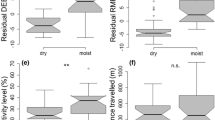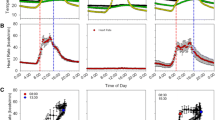Abstract
The common spiny mouseAcomys cahirinus and the golden spiny mouseA. russatus coexist in the extreme arid and hot parts of the Arava Rift Valley in Israel. The coexistence of these two species is through exclusion ofA. russatus from nocturnal activity byA. cahirinus, which is nocturnal. An attempt was made to study the daily activity rhythm response ofA. russatus to chemical signals released byA. cahirinus, in order to understand the mechanism of segregation. For this purpose oxygen consumption,\(\dot V\)O2, was studied in individuals ofA. russatus kept alone in a metabolic chamber in a constant ambient temperature of 32°C under two photoperiod regimes: 12L:12D, and constant darkness (D:D). After three days of\(\dot V\)O2 recording under these conditions, chemical signals released fromA. cahirinus were passed through the metabolic chamber. This treatment caused a shift in the activity rhythm only ofA. russatus kept at 12:12D, while a decrease in\(\dot V\)O2 rates ofA. russatus was noted in both groups. These results suggest that chemical signals released byA. cahirinus may play a role in shiftingA. russatus toward its diurnal activity.
Similar content being viewed by others
References
Aschoff, J. 1982. The circadian rhythm of body temperature as a function of body size, pp. 173–188,in C.R. Taylor, K. Johanson, and L. Bolis (eds.) A Companion to Animal Physiology. Cambridge University Press, Cambridge.
Depocas, F., andHart, J.S. 1957. Use of the Pauling oxygen analyzer for measurements of oxygen consumption of mammals in open circuit system and in a short lag, closed circuit apparatus.J. Appl. Physiol. 20:388–392.
Gause, G.F. 1934. The Struggle for Existence. Hafner, New York (reprinted 1964).
Haim, A. andBorut, A. 1981. Heat production and dissipation in golden spiny miceAcomys russatus from two extreme habitats.J. Comp. Physiol. B 142:445–450.
Haim, A., andLevi, G. 1990. Role of body temperature in seasonal acclimatization: Photoperiod-induced rhythms and heat production inMeriones crassus.J. Exp. Zool. 256:237–241.
Haim, A., Ellison, G.T.H., andSkinner, J.D. 1989. Thermoregulatory circadian rhythms in the pouched mouse (Saccostomus campestris).Comp. Biochem. Physiol. 91A:123–127.
Harrison, D.L., andBates, P.J.J. 1991. The Mammals of Arabia. Harrison Zoological Museum Publication, Kent.
Hill, R.W. 1972. Determination of oxygen consumption by use of the paramagnetic oxygen analyzer.J. Appl. Physiol. 33:261–263.
Kenagy, G.J., andVleck, D. 1982. Daily temporal organization of metabolism in small mammals: Adaptation and diversity, pp. 322–338,in J. Aschoff, S. Dean, and G. Groos (eds.). Vertebrate Circadian Systems. Springer-Verlag, Berlin.
Minors, D.S., andWaterhouse, J.M. 1989. Analysis of biological time series, pp. 272–284,in J. Arendt, D.S. Minors, and J.M. Waterhouse (eds.). Biological Rhythms in Clinical Practice. Wright, London.
Mrosovsky, N. 1988. Phase response curves for social entrainment.J. Comp. Physiol. A 162:35–46.
Noy-Meir, I. 1973. Desert ecosystems: Environment and producers.Annu. Rev. Ecol. Syst. 4:25–51.
Rozenfeld, F.M., Le Boulange, E., andRasmont, R. 1987. Urine marking by male bank voles (Clethrionomys glareolus Schreber, 1780; Microtidae, Rodentia) in relation to their social rank.Can. J. Zool. 65:2594–2601.
Rubal, A., Choshniak, I., andHaim, A. 1992. Daily rhythms of metabolic rate and body temperature of two murids from extremely different habitats.Chronobiol. Int. 9:341–349.
Schmidt-Nielsen, K. 1964. Desert Anaimals: Physiological Problems of Heat and Water. Oxford University Press, N.Y.
Shkolnik, A. 1966. Studies in the comparative biology of Israel's two species of spiny mice (genusAcomys). PhD thesis. The Hebrew University of Jerusalem (in Hebrew, English summary).
Shkolnik, A. 1971. Diurnal activity in a small desert rodent.Int. J. Biometeorol. 15:115–120.
Shkolnik, A., andBorut, A. 1969. Temperature and water regulations in two species of spiny mice (Acomys).J. Mammal. 50:245–255.
Stoddart, D.M. 1980. The Ecology of Vertebrate Olfaction. Chapman and Hall, London.
Author information
Authors and Affiliations
Rights and permissions
About this article
Cite this article
Haim, A., Fluxman, S. Daily rhythms of metabolic rates: Role of chemical signals in coexistence of spiny mice of the genusAcomys . J Chem Ecol 22, 223–229 (1996). https://doi.org/10.1007/BF02055094
Received:
Accepted:
Issue Date:
DOI: https://doi.org/10.1007/BF02055094




